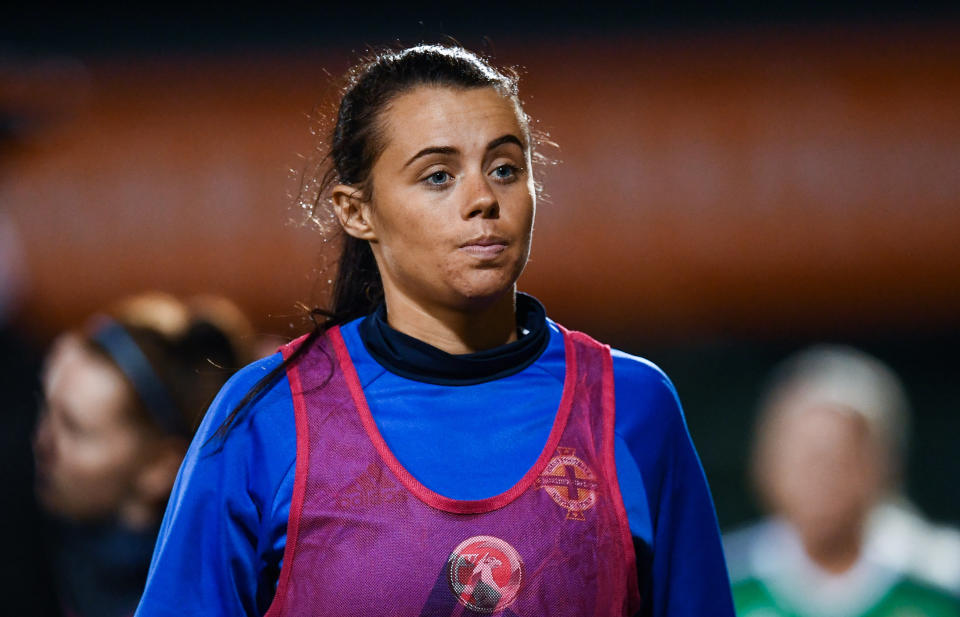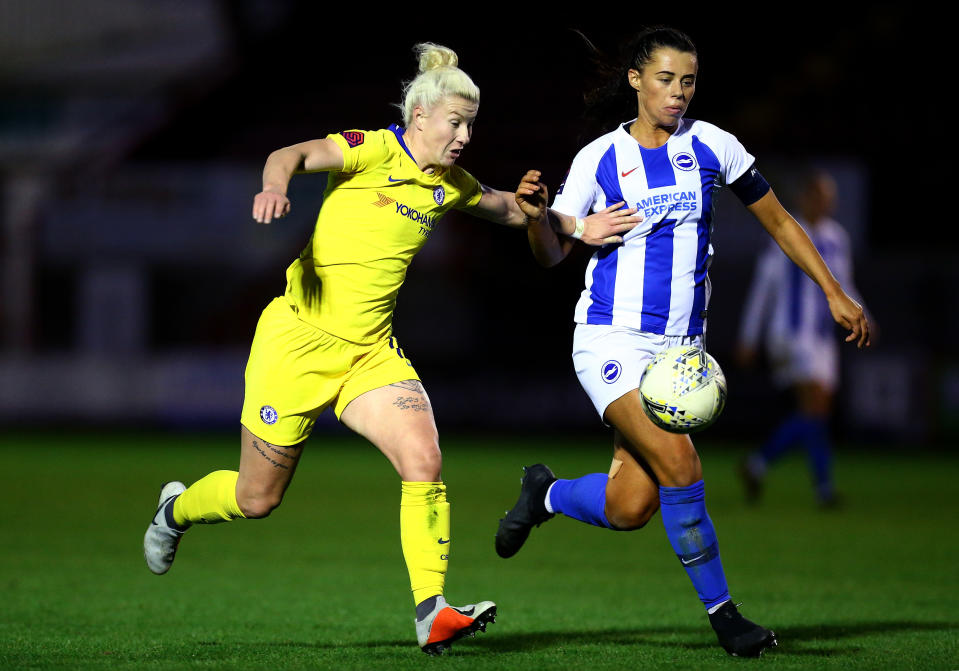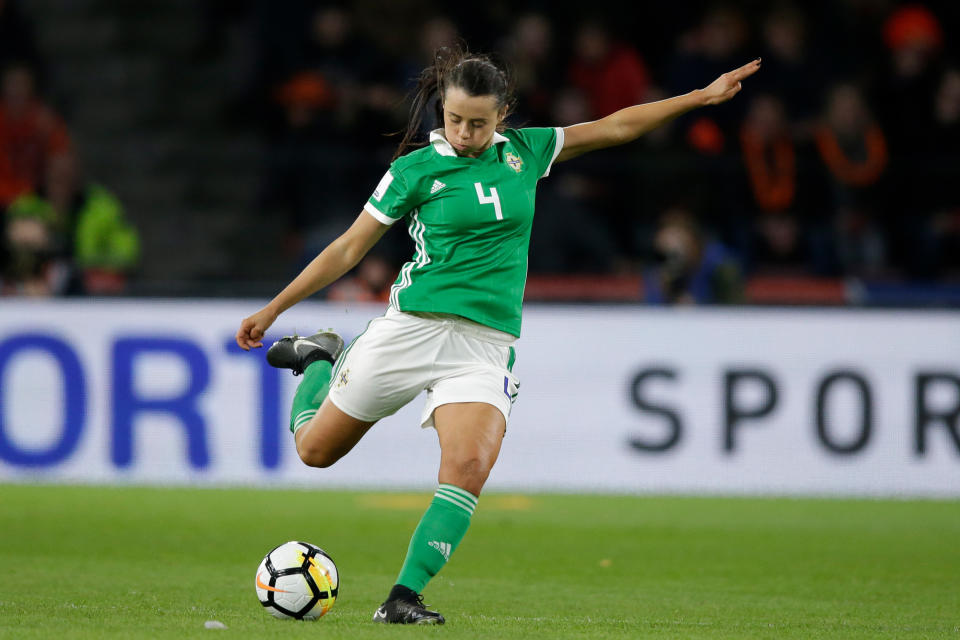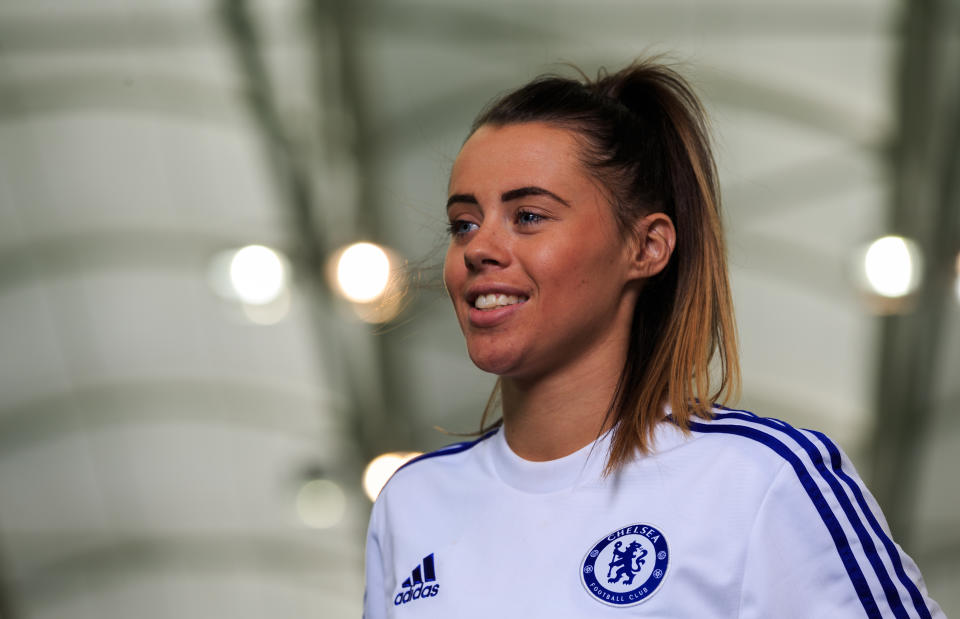Why ACL injuries involve greater risk and less support for female athletes

For all athletes, injuries are almost guaranteed. Everyone will pick up their fair share of niggles and knocks, but few are as devastating as an ACL injury.
An anterior cruciate ligament rupture is one the most immobilising injuries in sport and it’s one that’s all too common in women’s football. Elite players like Jordan Nobbs, Jessica Fishlock and Steph Houghton are just a few of the unlucky individuals to have suffered this fate.
Brighton & Hove Albion defender and Northern Ireland international Laura Rafferty is one of the most recent cases.
“I was shocked. I cried my eyes out,” she said in an exclusive interview with Yahoo Sport. “I didn’t think about the pain or the rehab, I thought about the year without football.”
READ MORE: Cristiano Ronaldo donates football boots to national team's under-17s women's team
READ MORE: England set to smash attendance record for match against Germany
The science behind the injury
Female athletes need to take extra precaution as they are more susceptible to damaging their ACL. According to sports-health.com, they are two to 10 times more likely to pick up the injury than their male counterparts.
The reasons for this ratio aren’t fully understood, however, some studies have narrowed it down to the female anatomy and hormones meaning that the way a woman is built puts her at higher risk of an ACL tear. The width of the hips can affect the alignment of the knees, causing the joint to move inwards. This alone can put stress on the ACL even before taking part in intense exercise.
“My hips are quite wide,” says Rafferty. “So my next aim for rehab is to start trying to slim down to cause less stress on my knees.”
A player’s menstrual cycle is another risk factor for serious ligament damage. Studies conducted by the National Athletic Trainers' Association showed that the fluctuation of oestrogen and other female hormones can cause the ACL to become loose and more susceptible to injury.
In addition to the initial injury itself, the chances of suffering a second injury are five times higher for those who have already torn it once before. Claire Rafferty, Ellen White and, more recently, Danielle Carter have suffered multiple ACL ruptures.
Issues off the pitch
Another factor that plays a part in recovery and rehabilitation is finance. Few women’s football teams outside of the top flight have the funds to provide private surgery for their players. Unfortunately, an alarming amount of players have been left to rely on the NHS for treatment or raise money to self-fund.
Ex-Liverpool player Emilie Revitt is one of the many footballers to struggle with this issue. Revitt told The Telegraph that Liverpool initially said that they did not have the funds to supply her with a knee brace, let alone private healthcare.
The club eventually agreed to pay for a private operation after Revitt was quoted a several-month wait on the NHS. Waiting times of up to 18 months, sometimes longer, can be expected without private healthcare.
Rafferty explained how Brighton pushed for immediate treatment. “The club gave me phenomenal support,” says the ex-Chelsea player. “From every member of staff, to every facility, to every teammate, it was amazing.
“I got my surgery within two weeks of finding out I’d done my ACL – it was the next possible slot. I was so lucky and I really appreciate it all.”
Finally discharged from the hospital for DAY 2 of recovery🙏🏼 Thankyou @officialbhafc for the incredible support 💙
Your messages have been amazing! Thankyou! Hope you all have a great weekend! In high spirits ✨ pic.twitter.com/c9wynBn6h1— Laura Rafferty (@LauraRafferty8) August 31, 2019
Reconstructing an injured ACL involves taking a part of the patient’s hamstring muscle to replace the damaged ligament. As well as adapting their body to its new ACL, athletes must also strengthen their weakened hamstring muscle as a consequence.
When asked whether more clubs should be offering their female players private healthcare, Rafferty replied: “Medical care should be a priority of every contract. Without the support I’ve had I could easily be in a very dark place. If you’re not healthy, you’re not happy.

“Ten years ago, teams weren’t full-time, so there were probably less injuries. But now all these bodies have gone into transition to become full-time and injuries do happen. It’s something clubs need to look at and put at the top of their priority list.”
READ MORE: ‘Women’s football must capitalise on World Cup success’
READ MORE: Megan Rapinoe: From tomboy to trailblazer
Unseen effects
Rafferty went on to talk about the unseen hardships following an ACL injury. “I couldn’t shower myself, I couldn’t go to the toilet on my own. I had to rely on other people for everything.
“I’ve had to shower in my bikini so my friends could help me in and out of the shower. It’s the little things like that, that are the tough parts and you almost don’t want to do them because it’s such hard work. It could take me up to two hours to have a shower.
“Mentally, that was one of the hardest things so far that I’ve had to do.”

Every day normalities are snatched away when recovering from reconstructive surgery. Rafferty’s mantra while still on crutches was to ensure she kept her mind active and positive. “Small things are the most important things,” she went on to say, “When your head goes, everything can go.
“I’ve had bad days but that’s normal. It’s when you’re stuck inside watching the same things on TV over and over again, that’s when you realise it’s a long road.
“It’s not a three-month injury, its a nine, 10-month injury or more, so you have to use your time wisely. That’s the biggest lesson I’ve learned: Be productive every day and better yourself in other areas.”
Even after returning to the pitch, the psychological scars remain. The fear of facing another injury is there in every challenge. Personal performances also run the risk of being subpar due to a blow in self-confidence.
For those without full-time contracts, the financial impact is another issue during recovery. With a minimum of six months of rehab required after surgery, footballers who balance their sport with day jobs risk huge losses in income.
Dealing with the injury going forward
Professionals and fans alike are calling for more research to be done into the frightening percentage of ACL cases in the women’s game. For those who don’t play in the Women’s Super League, England’s top division, an ACL rupture could mean more than a year out of action. In worse cases, some female footballers are forced to hang up their boots.
Revitt retired from competitive football aged 22 after suffering a second ACL injury and further ligament damage. Retiring from FC United, Revitt is one of many who have had their footballing careers cut short.
“I feel awful for those who don’t have the same treatment that I had,” Laura Rafferty says.
READ MORE: ‘It didn’t feel like football’: Phil Neville furious despite Cameroon win
READ MORE: Alex Morgan starting a family highlights challenges male athletes don’t have to consider

More and more clubs are improving their healthcare system for their female footballers. Tottenham Hotspur became one of the most recent to provide private medical cover after their promotion into the WSL this year. Unfortunately for teams that aren’t full-time, there’s still a way to go.
“Mentally, keep as strong as you can. That’s what holds everything together,” says Rafferty.
“If you’re not stable in your mind, nothing else will follow. It’s very easy to see the worst, but the worst has already happened and now it’s about how you come back from it. That starts with the mind.”
Featured from our writers

